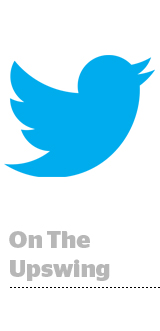
Twitter was the comeback kid in Q1.
The company experienced its second consecutive quarter of profitability, with 21% YoY revenue growth to $665 million – $575 million of it thanks to advertising.
Growth would have been higher – around 27% this quarter – if not for the headwind still blowing from the direction of the now fully deprecated TellApart, which took a $23 million bite out of Q1 revenue without contributing anything.
Twitter’s video-focused turnaround plan to woo advertisers and attract and retain users appears to be working. Twitter struck 30 new live-streaming partnerships in Q1, including a deal with Fox Sports for highlights of every FIFA World Cup goal and the rights to MLB live games and highlights.
Video is now responsible for more than half of Twitter’s ad revenue. Advertiser demand for in-stream pre-roll and mid-roll is growing, as is demand for video website cards, a direct response format that lets users click into a video ad for more information without leaving Twitter.
But supply still outstrips demand, and that’s an opportunity, Twitter CFO Ned Segal told investors Wednesday during the company’s first quarter earnings call.
With video engagement on the upswing – cost-per-engagement was down 28% for the quarter and ad engagement up 69% – the pitch to advertisers at Twitter’s second NewFront coming up on Monday will remain the same as last year: Twitter inventory is a bargain.
“CTR continues to get better based on better formats like video and better relevance against a bigger audience,” Segal said, pointing to MAU growth.
Twitter’s MAUs grew a modest 3% for the quarter, hitting 336 million. Daily active users increased 10%.
But what may or may not be growing is Twitter’s foray into programmatic. In October, Twitter said that it was starting an alpha test of programmatic buying and real-time bidding and that partnerships with demand-side platforms were in the works. No word from Twitter management on how those efforts are panning out.
When Twitter does open up its programmatic pipes, however, more revenue could come flowing – but so could a brand safety headache. Advertisers are increasingly enamored of Twitter’s video ad products, but they would likely be less so if there’s a chance their ads could show up as mid-roll on extremist content or a violent live news clip.
The data question
Twitter often gets lumped in with Facebook and Google, but it’s a completely different animal – especially from a data perspective, said CEO Jack Dorsey.
The company hasn’t seen any impact on its business as a result of Facebook’s Cambridge Analytica data scandal, he said.
“We’re different from our peers in that Twitter is public,” he said. “We serve the public conversation, so all of our data is out in the public and in the open. Our data business just organizes that data in real time” for brands, researchers and public institutions.
Dorsey said Twitter looks into who a client is before allowing firehose access and, echoing Facebook’s new catchphrase, noted that “we do not sell any personally identifiable information.”
“We feel really good about the data business, especially with all of the conversation going on,” Dorsey said.
Data licensing brought in around $90 million for Twitter in Q1, a 20% increase year over year.
On Tuesday, Twitter rolled out a new privacy policy in advance of Europe’s General Data Protection Regulation set to take effect in one month’s time. Twitter users also started seeing pop-ups on the platform with links to info about what data Twitter collects, how that data is used and the controls they have over it.
The data that advertisers use to target ads on Twitter isn’t part of the licensing business, including behavioral and demographic information and the CRM data advertisers upload through Tailored Audiences.
Although Twitter anticipates that GDPR could cool its monthly active user growth, “it’s too early to predict the impact that regulation is going to have on the business,” Segal said.
Stock shock
Twitter may have had a good quarter overall, but the stock was all over the place. Shares were up as high as 14% in early trading Wednesday morning, leveling out to a roughly 1% gain by the time the opening bell rang and dropping by around 1% by mid-morning.
The whipsaw was due to Twitter’s honest assessment of its growth projections for the rest of the year. Revenue gains will likely look more like 2016 over the next few quarters, the result of Twitter lapping the end of the large-scale cost restructuring and business recovery process it embarked on last year.
In late March, Twitter’s stock got dinged after Citron Research published a note claiming the platform’s data licensing business made it vulnerable to privacy regulation.
This post was syndicated from Ad Exchanger.

More Stories
ThinkTV campaign tackles The TV Advertising Paradox head-on
EXCLUSIVE: Most Americans Don’t Care If TikTok Shuts Down
Trump Grants TikTok a Second 75-Day Extension, Pushing Deadline to Mid-June